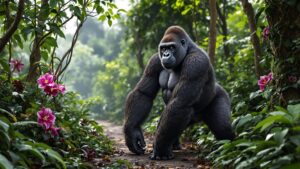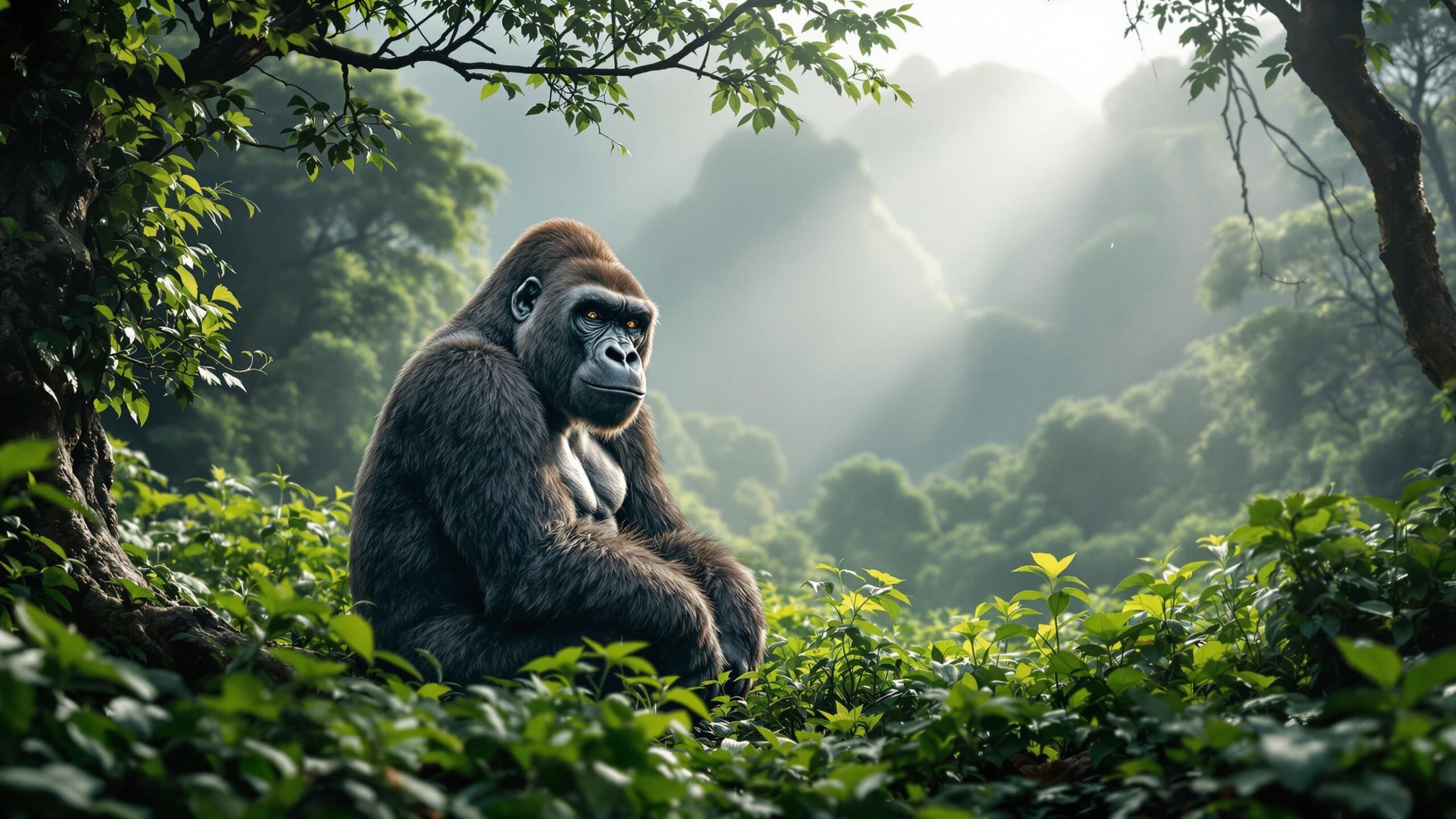Gorillas: The Gentle Giants of the Forest
In the quiet mist of a central African morning, a rustle in the thick undergrowth signals more than just movement—it hints at majesty. From behind a curtain of foliage, a massive silverback steps into a clearing, his muscular frame commanding, yet his eyes calm and intelligent. This is the gorilla, a creature of immense power and startling gentleness, the largest of all primates and one of our closest relatives in the animal kingdom. These forest giants are not only awe-inspiring due to their size and strength but also because of their profound emotional depth, tight-knit social structures, and vital ecological roles. This article dives deep into the world of gorillas, exploring their biology, diversity, behaviors, and the urgent need for their conservation.

Eastern Gorilla
Eastern Gorilla (Gorilla beringei): The Gentle Giants of Central Africa Hidden in the mist-draped mountains and dense rainforests of Central and East Africa live the largest and most enigmatic of the great apes—the Eastern Gorilla (Gorilla beringei). These gentle giants, often referred to as the kings of the jungle, are not only icons of African biodiversity but also keystones of tropical forest health. With their deep brown eyes, massive builds,

Western Gorilla
Western Gorilla (Gorilla gorilla): Guardians of the Green Heart of Africa Deep within the lush, steaming rainforests of Central Africa, a powerful yet gentle presence moves quietly among the shadows. It is the Western Gorilla (Gorilla gorilla), a critically important species of great ape and the largest living primate on Earth. Shy, intelligent, and family-oriented, Western Gorillas are the unsung guardians of the tropical forests they call home. They live
Understanding Gorillas: The Biology Behind the Strength
Gorillas are ground-dwelling, predominantly herbivorous great apes that inhabit the forests of central Sub-Saharan Africa. They belong to the genus Gorilla, one of the four genera of great apes, alongside Homo (humans), Pan (chimpanzees and bonobos), and Pongo (orangutans). Adult males can weigh up to 440 pounds and reach heights of nearly 6 feet when standing upright, while females are considerably smaller. One of the most iconic features of a mature male gorilla is the silvery band of hair on its back, earning it the name “silverback.” Despite their formidable appearance, gorillas are generally peaceful and spend much of their time feeding, resting, and caring for young. Their diet consists primarily of leaves, stems, fruit, and bamboo shoots. With large, barrel-shaped chests and strong jaws adapted for processing tough vegetation, gorillas are marvels of evolutionary design for forest foraging. Socially, gorillas live in groups called troops or bands, usually led by a dominant silverback male who provides protection, mediates conflict, and guides daily movement. Communication occurs through vocalizations, body language, and facial expressions, with over 20 recognized sounds, including grunts, hoots, and chest beats. Their social lives are rich with bonds of loyalty, affection, and cooperation.
Mountain Gorillas: The Icons of Conservation
Perhaps the most famous of all gorillas are the mountain gorillas (Gorilla beringei beringei), a subspecies of the eastern gorilla. Found in the Virunga volcanic mountains of Central Africa and Bwindi Impenetrable Forest in Uganda, mountain gorillas live at altitudes of 8,000 to 13,000 feet in mist-shrouded forests. Their thick fur helps insulate them from the cool mountain climate, and their diet includes a wider range of leaves and stems than their lowland cousins due to fewer fruiting trees. Mountain gorillas live in stable family groups that can number up to 30 individuals, though 10 to 15 is more typical. These groups are centered around a dominant silverback who fathers most of the offspring, protects the group, and makes daily decisions. Dian Fossey’s groundbreaking research in the 1960s and her subsequent conservation efforts brought international attention to these gorillas, transforming them into symbols of endangered species conservation. Despite decades of threats from poaching, disease, and habitat encroachment, the mountain gorilla population has rebounded thanks to intensive conservation programs, including eco-tourism, veterinary interventions, and anti-poaching patrols. Today, their numbers exceed 1,000 individuals—a conservation success, though their survival remains precarious.
Eastern Lowland Gorillas: The Forest Titans of the Congo
Eastern lowland gorillas, also known as Grauer’s gorillas (Gorilla beringei graueri), are the largest of all gorilla subspecies. They inhabit the lowland tropical rainforests and forested mountains of the eastern Democratic Republic of Congo. These gorillas are more elusive than their mountain relatives, dwelling in dense, remote jungles far from human settlements. Grauer’s gorillas exhibit a varied diet of fruits, leaves, seeds, and bark. They are adept climbers and will occasionally forage in trees, although adults tend to remain grounded due to their size. Social groups resemble those of mountain gorillas, with a silverback leading several females and their offspring. Years of conflict in eastern Congo have taken a devastating toll on these gorillas. Poaching, mining, and civil unrest have severely fragmented their habitat and reduced their population. From an estimated 17,000 in the 1990s, recent surveys suggest fewer than 4,000 remain. Conservation efforts are difficult due to ongoing instability, but organizations are working with local communities to develop sustainable, gorilla-friendly alternatives to destructive land use.
Western Lowland Gorillas: The Adaptable Forest Dwellers
The western lowland gorilla (Gorilla gorilla gorilla) is the most widespread and numerous of all gorilla subspecies. Found in the dense rainforests of Cameroon, Central African Republic, Gabon, Congo, and Equatorial Guinea, these gorillas are more arboreal than their eastern cousins, frequently climbing trees for fruit and shelter. Smaller in size and lighter in color, western lowland gorillas are also known for their more extensive vocal repertoire and expressive communication. Their diet is rich in fruits, but also includes leaves, stems, and insects. Western gorillas typically live in family groups led by a silverback, with social structures shaped by ecological pressures and food availability. Despite being the most numerous gorilla, western lowland populations are still at risk. The Ebola virus has decimated entire communities, and bushmeat hunting continues to be a major threat. Habitat loss due to logging and agriculture adds further pressure. Conservationists have focused on habitat protection, community engagement, and disease monitoring to safeguard these adaptable yet vulnerable apes.
Cross River Gorillas: The Elusive Mountain Shadows
Cross River gorillas (Gorilla gorilla diehli) are the rarest and most endangered of the gorilla subspecies. Fewer than 300 individuals remain in a fragmented habitat along the mountainous border between Nigeria and Cameroon. Their small, scattered population makes them incredibly difficult to study, and sightings are rare. These gorillas live in rugged terrain, with steep cliffs and forested hills providing refuge from human encroachment. Because of their limited range, genetic diversity is a concern, and any habitat loss has outsized effects. Conservation efforts for Cross River gorillas have focused on establishing protected corridors between forest fragments, anti-poaching measures, and engaging local communities as stewards of the land. The Cross River gorilla’s survival is one of the most urgent conservation priorities in Africa. Every birth is celebrated, and each troop’s movement is closely monitored through camera traps and ranger patrols. They serve as a poignant reminder of how easily biodiversity can teeter on the edge.
Gorilla Intelligence: Minds Behind the Muscles
Gorillas are not only physically powerful but mentally impressive. Captive gorillas like Koko, who learned over 1,000 signs in American Sign Language, have demonstrated the capacity for complex communication, emotional depth, and self-awareness. In the wild, gorillas exhibit behaviors such as using sticks to measure water depth, manipulating tools, and playing games. They also express a range of emotions including joy, grief, empathy, and even a sense of humor. Mothers gently cuddle their infants, siblings wrestle in play, and silverbacks show signs of protective affection toward their troop. Such behaviors underscore their cognitive sophistication and the need for ethical considerations in both wild and captive settings. Understanding gorilla intelligence enriches our understanding of primate evolution, consciousness, and the nature of intelligence itself. It also strengthens the argument for their protection as sentient beings with rich inner lives.
Gorillas and Their Ecosystems: Architects of the Forest
As mega-herbivores, gorillas shape their environments in profound ways. By feeding on a wide variety of plants, they help manage vegetation growth and encourage forest diversity. Their droppings serve as natural fertilizers and aid in seed dispersal, contributing to the regeneration of their forest habitats. Gorillas often follow traditional trails and build new sleeping nests each night, flattening ground vegetation in a way that creates micro-habitats for other species. Their presence indicates a healthy forest ecosystem, and their disappearance often foreshadows ecological imbalance. Their role as keystone species means that protecting gorillas indirectly benefits countless other organisms that share their habitat. From birds and insects to medicinal plants and canopy trees, the ripple effect of gorilla conservation extends across the forest web.
Conservation Challenges and Global Efforts
Despite their importance and appeal, gorillas face an array of existential threats. Habitat destruction through deforestation and agriculture, poaching for bushmeat or illegal trade, disease transmission from humans, and civil conflict all contribute to population declines. International and local conservation organizations have launched multifaceted efforts to address these issues. Protected areas have been expanded, eco-tourism initiatives have created economic incentives for communities, and health monitoring has helped detect and respond to disease outbreaks. Sanctuaries and rehabilitation centers offer care for orphaned or injured individuals. Yet the path forward is still precarious. Gorillas reproduce slowly, with long intervals between births. Every loss is significant. Conservation requires long-term funding, political will, and the support of the very communities that share space with gorillas.
The Human Connection: Why Gorillas Matter
Gorillas touch something deep within us. Their faces are expressive, their families familiar, their gestures relatable. Watching a gorilla cradle her infant or a silverback calmly observe his group evokes a sense of shared ancestry and emotional kinship. In art, literature, and media, gorillas have been portrayed as monsters, heroes, and sages. But in reality, they are vulnerable beings navigating the challenges of a rapidly changing world. The more we learn about gorillas, the clearer it becomes: protecting them is not just about saving a species. It’s about preserving the dignity of life itself.
Looking Ahead: A Call to Protect the Forest Kings
Gorillas stand at a crossroads between extinction and survival. Their fate depends on the choices we make today—how we use land, where we invest resources, and what we choose to value. Each subspecies tells a story of resilience, adaptation, and the quiet strength found in community. Exploring the world of gorillas invites us to reconnect with nature and reconsider our role as stewards of the Earth. As you journey through the profiles of mountain gorillas, lowland titans, and forest shadows, remember that each one is a symbol of hope and a call to action. Dive deeper into their stories, support organizations making a difference, and spread awareness about these gentle giants. In doing so, you become part of a movement to ensure that the forests echo with the chest-beats of gorillas for generations to come.

